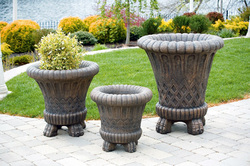Reference:
LaLiberte, Kathy. "How to Create Sensational Pots and Planters." Gardeners Supply. Gardeners.com, n.d. Web. 20 Mar. 2014. <http://www.gardeners.com/Planters-That-Stand-Out/5325%2Cdefault%2Cpg.html>.
0 Comments
"When most people think about New Orleans homes, they imagine outdoor spaces -- cast iron railings and lush, private courtyards. And those are absolutely magnificent. But, New Orleans interiors are pretty special too. With the city’s mix of French, Spanish, African, Haitian, and American Low-Country heritage, nothing is really inappropriate. I've even seen crumbling plaster become a decorative element. But, for that quintessential New Orleans style -- whether you prefer an apartment in the French Quarter, a colorful shotgun cottage, or a grand manor in the Garden District -- mix in some of these: Ornamental Iron If you don't have that French Quarter balcony with the cast iron railings, you can still enjoy decorative ironwork. Hang a gate or fence section on the wall as art or use it as a headboard. Top a three-sided balcony piece with glass or marble to make a console table". Classical Urns and Garden Statuary Reference:
French, Leah. "Get the Look: New Orleans Style." About.com Flea Markets & Yard Sales. About.com, n.d. Web. 17 Mar. 2014. <http://fleamarket.about.com/od/stylestrends/tp/neworleansstyledecorating.htm>. Overview The shamrock is an indoor plant, often associated with Ireland and good luck. The leaves are like three-leaf clovers with delicate white or light purple blossoms. It is grown from bulbs.Your plant will require a rest period during the year, when it is allowed to go dormant. Choose a time that the leaves start to look a bit limp and stop watering it. As the leaves turn brown, clip them off. Place your shamrock in a cool, dry dimly lit room for one to three months. Bring it back out into a well-lit location, but not full sun, water it and feed it with a general-purpose houseplant fertilizer. Re-pot your plant at this time if it appears to be crowded in its current pot or if you want to divide it. Step 1 Choose a new plant container for your shamrock plant. It should be 2 to 4 inches wider than the original pot and 2 to 4 inches deeper. Step 2 Scatter stones or broken pottery pieces over the bottom of the container. Pour in 2 to 3 inches of commercial potting soil. This soil will add nutrients to your shamrock's roots, and it is guaranteed to be disease and weed-seed free. Step 3 Turn the plant upside-down, while holding onto the base of the plant, and tap on the bottom of the pot. The plant should slide right out, but if it doesn't push through the bottom of the drain hole with your fingers. Step 4 Place the root ball of the plant into the new container. The top of the original soil should set about an inch below the top of the new pot. If it is too low or too high, adjust the soil beneath it. Step 5 Pour additional soil around the root ball, pressing gently with your fingers to remove any air pockets and to stabilize the plant. You are finished when the added soil is even with the top of the original potted soil. Step 6 Water your shamrock with enough water until it comes out the bottom drainage hole. Set it in it's original spot. Reference:
Ellis, Karen. "How to Repot a Shamrock Plant." GardenGuides. Gardenguides.com, n.d. Web. 05 Mar. 2014. <http://www.gardenguides.com/100033-repot-shamrock-plant.html>. |
AuthorArchives
January 2016
Categories
All
|





















 RSS Feed
RSS Feed

